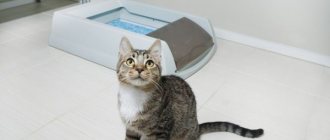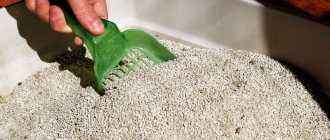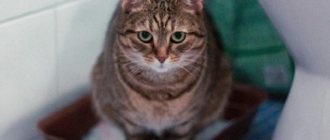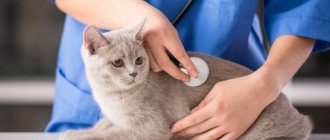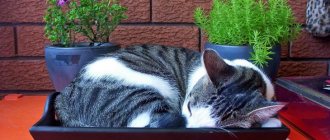Why does a cat get stressed when moving?
Imagine that you live in one place all your life, don’t go anywhere and only see the world around you from the window.
At the same time, the world outside the window is safe; when you look at it, you feel the smell of home and you do not have a feeling of danger. But in one moment everything changes - new surroundings, new smells, new life. Of course, against the backdrop of such changes, stress arises. As you can understand, above we described the life of your pet that was relocated. After moving, the cat (or cat) finds himself in a place where everything is unfamiliar to him. Initially, he has only one instinct - to protect himself.
Cat behavior after moving
Immediately after moving to a new apartment, the animal is usually slaughtered in a place where it feels safe. For example, under the bed or between cabinets. A small space around a cat allows her (him) to feel safe.
The best decision on the part of the owners at such a moment is to make the place chosen by the pet as comfortable as possible for it. For example, put his favorite blanket in this place or put his scratching post - any items that you took from the old house will do.
Before moving into a new apartment with a pet, we recommend that you try to cover all the places where the cat can “hide” with danger to its health. It is best for the animal to choose a place from where you can see it, and where it can see you and the environment. A bad option for the first place for a cat to stay in a new apartment is behind the sofa, bed and other furniture. This will not only be additional stress for the animal, the lack of visual contact with the owner, but also potentially traumatic.
What to do if your cat doesn't eat after moving
The most important thing is not to panic and not to try to force feed the animal. Remember the animal's instincts. When a cat gets so hungry that it can no longer endure it, it will go in search of food; the animal cannot starve itself to death.
To prevent your cat from having to go far to look for food, place two bowls next to it - one with food, the other with water. It’s better to put your pet’s favorite treats so that he can quickly respond to them and eat them.
Note that each animal has its own character and its own opinion on how to act after moving. Some cats, on the contrary, after moving, try to immediately eat for the future, so that if such stress suddenly occurs again in the next few hours, they will not remain hungry. So, if your pet has already eaten his allotted amount, but clearly wants more, be sure to feed him extra, this will help him relieve stress.
Help for newborn kittens
Young kittens often have problems with bowel movements. The fact is that kids need outside help. A cat should lick her babies not only to clean their fur. A gentle massage stimulates the intestines and ensures blood flow. Licking helps the kitten get rid of the contents of the intestines, because he cannot do this on his own.
In the case when a young and inexperienced mother refuses to care for her offspring, a person must help. Help may also be required if the adopted kitten is one month old or less.
In order to perform a massage, you need to take a small piece of soft cloth or cotton wool and moisten it with warm water. Now make short longitudinal movements from chest to tail across the entire tummy. Movements should be very soft, gentle, not causing discomfort to the kitten. There is no need to press on the tummy, just stroke it.
The cat does not go to the toilet after moving
As in the situation with food, the best recommendation in this case for animal owners is to simply wait. But to prevent your pet from spoiling your new apartment, we recommend:
If your pet hides in a corner, you need to place an old tray near it. If you want to place the tray in a different place in the future, you can accustom your cat to this after the pet’s stress has passed.
If the cat went to the toilet in the wrong place, you need to reproach him, do not let him get used to such permissiveness.
Don’t forget to cover from potential “damage” all the furniture in the house that could absorb the smell if the animal doesn’t immediately go where to go to the toilet.
As with food, a cat in a new place may not go to the toilet for 3-4 days due to stress. This is quite common practice. If you create comfortable conditions for him to go to the toilet by placing his tray nearby, he will certainly do it.
How can you tell if your kitten is constipated?
Constipation can be expressed not only in the absence of stool. This factor can be missed if the pet has access to the street and defecates there. What are the signs that indicate that a kitten is constipated?
- Frequent but unproductive attempts to go to the toilet.
- The kitten meows when it tries to empty its intestines, walks around the tray for a long time and is afraid of it.
- Dry, hard, small stools.
- Mucus or blood in the stool.
- Lack of appetite.
- The kitten does not lick itself, is lethargic, has lost weight.
- A small amount of liquid feces after the kitten has been pushing for a long time.
When do you need veterinary help?
Many owners call a veterinarian for their pet on the first or second day after moving, when they see that it does not leave the corner for a long time. Or they go looking for advice on forums on what medications they can give to their pet. We categorically do not recommend doing this.
You should call a veterinarian or take your cat to the clinic only if:
- There are obvious signs of poor health of the animal: constant nausea, severe drowsiness, loss of tufts of hair;
- The animal does not leave its corner for more than 4 days and refuses to eat and go to the toilet;
- The animal is lethargic, it does not try to defend itself when you want to pick it up.
There is no point in giving the animal pills and injections once again. A trip to the vet is another stressful experience for your pet, so it’s best to avoid it.
Source
Alarm Signals
To identify problems, you should pay attention to your cat's behavior. The following symptoms are warning signs:
- loud, unusual meowing;
- the pet tramples, presses against the tray;
- weight loss, refusal to eat;
- the stomach seems to be swollen, the cat does not allow him to touch it;
- sometimes traces of blood or pus are visible in the cat's litter box;
- anxiety, plaintive meowing;
- the animal tries not to lie on its stomach;
- signs of intoxication may appear, including vomiting.
If you notice any of these signals, promptly take measures to provide assistance, find out the reasons, and consult a doctor.
Why doesn't a kitten go to the toilet after moving?
0. Before your cat arrives, ALWAYS check if there are any inaccessible or hard-to-reach places in your house where a small animal can get through (batteries, gypsum board housings, places with a lot of wires and expensive household appliances, pipes, unfinished repairs, etc. ) If the cat gets in there (and he will 100% get in there), you won’t be able to lure him out of there by any force.
1. Immediately after arriving at a new home, the cat will hide in the first hard-to-reach place that happens to be on its way. This could be a shelf in a closet, a place behind the toilet, a gap between a refrigerator, closet or sofa and a wall, etc. This will be his habitat for the next few weeks. Place a tray with filler and a bowl of water next to this place. DO NOT pull the cat out of its shelter, do not try to forcefully introduce it to life, do not look into the hole, do not pet it, do not try to lure it with food, force feed it, and do not try to drive it out of there. Let the cat sit in his shelter for as long as he needs to understand that it is safe here. Then he will slowly go out, curiosity will drive him to investigate. BUT at the same time, the cat should always be able to return to the place that he considers safe, where you do not see him and he does not see you. Do not block his escape route, give him the opportunity to believe that he can hide in the house.
2. For the first 2-3-4 days, the cat may not eat, drink or go to the toilet. DON'T BE SCARED - THIS IS NORMAL. The animal experienced stress during the move and continues to experience it in the new place. New smells, noises, images - all this frightens him and completely disorients him. No feeling of hunger will force him to leave the shelter until the stress subsides at least a little and he gets used to it. All animals have their own character, they all need different time to get used to. Try to be patient. Don't worry, a cat is practically incapable of starving itself. Only a person can consciously refuse food. The instinct of self-preservation will win.
3. At first, the most important thing is to control where the cat goes to the toilet. The tray should be located so that the cat can reach it with minimal effort - that is, as close as possible to the place where he is hiding. If the litter box is at the other end of the room, he will not go there out of fear, but will simply go to the toilet where he thinks it is safe. He will not put himself in danger and will simply find a safe place to go to the toilet. Try not to force your cat to choose between the usual litter box and the fear of being discovered. Since the animal can behave unpredictably, just in case, remove all valuables from the floor, if possible cover the furniture with plastic, etc. If your cat goes to the toilet in the wrong place several times, try to change something. Tray size, location, type of filler, etc. If possible, place the cat in a limited space with the tray. At the shelter, all animals use a litter box, so this could just be a stress-related glitch.
Why doesn't the kitten poop and what to do in such a situation?
Has your kitten not pooped for a day, a few days, a week? This problem is very common because... The digestive system of small kittens already works imperfectly, and after moving to a new home, difficulties begin even more so, because the nutritional system often changes, and stress takes its toll. We will not touch upon the issue of kittens under one month of age, because... this is a special topic. Let's talk about those who are older.
Nutrition
Another cause of intestinal dysfunction is poor nutrition. The animal's body needs time to get used to new food. It is especially important not to change the feeding pattern during the kitten’s adaptation after moving to a new home. To do this, you need to find out from the previous owners how they feed the kitten, what its favorite food is. It is best to take some food from the previous home and feed it to your pet for the first few days. You can purchase food of the same brand.
New foods should be introduced gradually. The kitten can be fed dry or wet kitten food or natural food. If the diet includes dry food, you need to ensure that the animal always has access to clean water. When feeding natural food, to improve intestinal function, bran should be added to the food. This measure will help prevent constipation.
Cats are carnivores and their natural food is meat. The kitten begins to gradually become accustomed to animal products from the age of 1.5 months. This needs to be done gradually. The meat should be cut into small pieces and boiled without salt and spices for 10-15 minutes, cool. You can grind it to a puree. It is good to use baby puree in jars as a meat supplement for kittens.
Constipation can occur due to lack of fluid. Make sure your pet drinks enough, especially if he eats dry food.
Why the kitten does not go to poop: the main reasons
Let's figure out in order what the problem might be. But first, make sure that there is no situation where you simply haven’t found the place where the animal is doing this. If a kitten does not go to the toilet, this sometimes means that he has found a secret place for himself.
One of my cats, when we took her in, did not go to the toilet for 2 weeks. More precisely, we thought so. But after 2 weeks it turned out that she had taken a fancy to the suitcase under the wardrobe. The suitcase kept everything inside and nothing was visible. Oddly enough, we didn’t smell it either, although no one had complained about the sense of smell before. When we noticed that the cat was coming out from under the wardrobe and climbed in, we saw that the suitcase had turned into a slurry of urine and feces.
A very small kitten cannot poop without help
Very small kittens do not know how to go to the toilet on their own. The mother cat licks their anuses, stimulating defecation. If there is no mother or the mother does not care enough for the kittens, the massage should be done by the breeder. Massage the abdomen and the genital and anal areas after each feeding. On average, a kitten should go to the toilet 3 times a day.
Peristalsis did not turn on
Young kittens (usually from 1 month to 2-2.5 months) may suffer from constipation when their gallbladder does not yet work properly and/or peristalsis has not started. In this case, inflammation of the intestinal walls may occur. Signs of the condition are as follows: the kitten eats poorly, is lethargic and thin, develops slowly, and when you palpate the abdomen, lumps are felt (like pebbles). These kittens usually do not have a bloated stomach, despite being constipated.
This condition, if not eliminated, is dangerous. Sometimes a sorbent helps a kitten, which collects everything accumulated and removes it. If after this everything starts to improve within a day or two, then you can still drink the sorbent for 2-3 days - and then peristalsis will begin to work on its own. But if the sorbent does not help within 1-2 days, this means that the condition is more serious and you will need injections and oral medications. You do not need to prescribe such medications yourself - contact your veterinarian.
Artificially fed kitten
Artificially fed kittens often have the problem of constipation. In this case, a glycerin suppository can help. It must be purchased at a regular human pharmacy, where candles for newborns are sold. But this candle is too big for a kitten, so first you need to prepare it properly. Heat the candle at room temperature. When it softens enough, stick an insulin syringe into it without a needle and add glycerin to it. Then the glycerin needs to be squeezed back out of the syringe, forming a microcandle to the size of the kitten’s anus. When the candle hardens a little, it needs to be lubricated with Vaseline and inserted into the anus. The kitten will poop in a few minutes.
After moving, the kitten does not go to the toilet due to stress
When you adopt a kitten and he doesn't poop, you're wondering what to do? I immediately want to fix something, because not going to the toilet for a long time is harmful. However, you should know that kittens, when they get to a new home, rarely go to the toilet for the first week, because... they are stressed. But usually the situation is resolved in 3-5 days.
Accordingly, if the kitten does not poop for a day or two, and also if the kitten does not poop for 3 days after moving, this is not yet a problem. The problem is if the kitten doesn’t poop for 4 days or 5 days, then it’s worth asking what to do and what are the reasons for such rare bowel movements.
Why doesn't the kitten poop for 1 day?
Even if the animal successfully survived the stress and began to visit the litter box regularly, failure may occur over time. As a result of stress or poor nutrition, a kitten may not go to the toilet for a day - this is normal. For example, the owner gave him bones or rice porridge to eat - this can cause the stool to become fixed. Therefore, first of all, it is worth thinking about what nuances there were in the diet and could they have led to a delay? But even without errors in the diet, if a kitten poops once a day, this is normal and nothing needs to be changed. This is normal for most cats.
Why doesn't my kitten poop for 2 days?
If your animal consumes industrial food, then it will go to the toilet 1-2 times a day, or even more. But there should be no more stool once every 2-3 days while drying. This happens often on a natural diet - this is the norm. Read about the reasons below.
However, even a drying kitten may have stool retention for 2-3 days, or even more, if, for example, he ate an inedible item and an intestinal blockage occurred. So, straight people who don’t go to the toilet for 2 days need to take it calmly and sound the alarm later, but for dryers, a two-three day delay may indicate a problem. Start monitoring your pet's condition: if other signs of illness appear, you need to go to the veterinarian.
Why doesn't my kitten poop for 3 days?
Sometimes a kitten poops once every 3 days. If your kitten has always been like this and is on a natural diet, this is normal. Many owners state that their kitten does not poop for three days, but feels absolutely normal. There are simply cats that are prone to constipation or infrequent bowel movements. They may have stool quite rarely.
Symptoms of constipation and delayed bowel movements
Signs that a cat has problems with bowel movements are immediately noticeable. The animal becomes nervous, there is no feces in the tray. The cat makes frequent but useless attempts to defecate. He can dig for litter for a long time, sit in the tray, meow plaintively or shrilly.
© shutterstock
This condition is considered relatively normal for old cats and young kittens. However, even they should have bowel movements at least once every 2-3 days. Other symptoms include :
- lethargy of the cat;
- the animal's refusal to eat;
- lethargy;
- swollen belly;
- tense and hard stomach.
The cat may not allow its owner to come near it to avoid unnecessary pain. The animal tries to lie on its side, but not on its stomach. Neutered cats experience constipation more often than their full-fledged counterparts.
Symptoms of urinary retention
Symptoms of urinary retention are in many ways similar to those of constipation. The cat rarely goes to the toilet, despite the animal's frequent urges and attempts to pee. During the process itself, a loud and plaintive meow is heard. This indicates that the cat is in pain. Other symptoms when an animal cannot go to the toilet normally :
- purulent discharge and blood may appear in the urine;
- the stream is crooked and can get past the tray, beyond its limits;
- sometimes after urination small crystals are visible and foreign bodies come out;
- the cat does not always have time to run to the toilet (especially if it could not go to the toilet for a very long time);
- urine color darkens;
- emptying the bladder does not bring relief, since it is not completely emptied.
© shutterstock
The animal (even a small kitten) becomes aggressive, hisses, and does not allow itself to be touched, especially its swollen belly.
How long can a kitten go without pooping?
Many readers ask the question, how many days can a kitten go without pooping? That is, how many more days can you not worry, and when is it necessary? We consider 5 days to be the critical point. However, this does not mean that before this you just need to look at the animal without doing anything. In some situations, 3 days is also too much.
If the kitten is fed commercial food, it will have frequent stools - 1-2 times a day. If there is a delay of 2 days, you don’t have to worry, but if there is a delay of 3 days or more, this is already a reason to take action.
In kittens that eat natural food, the process takes longer: they can visit the litter box once every 2-3 days, although there are also those who regularly go every day. If a natural kitten does not have stool for 4-5 days, the situation also needs to be corrected. After all, a week without a bowel movement can already end critically.
If the cause of stool retention is an ingested foreign object that has blocked the intestines, or gastrointestinal pathology, then tragic consequences can occur earlier than in a week. Therefore, it is imperative to monitor the animal’s condition and, if additional signs of ill health occur, contact a veterinarian, even if only 3 days have passed.
Why doesn't a kitten poop for 4-5 days?
There are cases when an animal ate boiled bones or swallowed an inedible object, and therefore developed an intestinal obstruction. Blockage with dense feces is also possible. Then there may be no stool for a week, but usually by 4-5 days the owners themselves are sounding the alarm.
If there is no stool for 4-5 days, you should pay attention to the kitten’s well-being. Signs of intestinal blockage, in addition to the absence of stool, will be:
- lethargy, the animal tries to hide out of sight;
- some cats, on the contrary, run after the owner and cry, as if complaining;
- lack of appetite and sometimes refusal of water;
- tense stomach;
- abdominal pain;
- metallic sound when tapping the abdomen;
- bloating (sometimes);
- vomiting, sometimes with feces.
It is impossible for an inexperienced person to determine the presence of obstruction at home. Intestinal blockage leads to the death of the animal within a week, so the sooner you contact a veterinarian, the greater the chance of recovery.
If the cause of the obstruction is a foreign object, surgery will most likely be prescribed. If the cause is stagnant dry feces, the veterinarian may try to solve the problem with an enema. But you cannot give an enema in such a situation on your own: in some cases this threatens intestinal rupture.
However, if a kitten who is on a natural diet regularly has stool every 4-5 days, it is appropriate to say that there is systematically some kind of problem, either related to the characteristics of the gastrointestinal tract, or related to the diet. Often the problem lies in the diet. Here it is appropriate to talk about the situation of our reader, who asked why the kitten poops rarely and little.
QUESTION FROM A READER
My Scottish kitten is 2 months old and she doesn't poop for days. I adopted her at the age of two months. Three days before, her mother stopped feeding her, and from the age of one month, the former owner, in addition to her mother’s milk, gave Royal Canin food for her mother and kittens. And then the cat went to the toilet twice a day. But since the day I took her, she has been suffering from constipation. At my house this kitten doesn't poop for a long time.
On the first day she went to the toilet, after that only on Friday and Monday, that is, after 6 and 3 days. She didn't go anymore. I have already been to four different clinics, everyone says completely different things, but nothing changes. My kitten doesn't want to poop as often as I expected. On the stool scale, I can compare her stool to type 4. When she goes to the toilet, she doesn’t push, she copes in literally 2 minutes.
If a kitten doesn’t poop for 2 days, that’s fine, but when there’s no stool for several days, I don’t understand it. Overall the cat has a very good appetite and is very playful. We play all day long. At night she wakes up twice to go to the toilet and once to have a snack. After that I have to play with it a little, because... she really wants it.
Now I feed her natural food. But first, so that she wouldn’t get a shock, I bought the same food as her former owner told me. She refused to eat it. And then I immediately went to the store and bought a set that consisted of ready-made cat milk, yogurt and pudding: she liked everything except the yogurt. And I cooked her chicken fillet, very finely chopped with broth. On Monday and Tuesday she drank only broth, did not eat meat from it, and only on Tuesday evening did she eat all the meat.
From that moment on, her appetite became very good. On the fourth day I gave her boiled liver. On the fifth I added chicken yolk. For a week she ate that set and chicken fillet with broth, and a little more liver. But I went to the toilet for the second time only five days later. On Saturday, I foolishly gave her a small piece of boiled pike. And that same evening I found your article about how to properly feed kittens of this breed. I had read a lot before, but all the information was not so comprehensive. And from that day I began to adhere to what you wrote.
The entire time I have her, she eats 6 times a day, including at night. A week later I started giving her cottage cheese with 10 percent cream. Yesterday for the first time I made a mix of chicken and turkey fillet and some veal, navels, chicken and turkey hearts, with chicken liver. She was delighted. But she went to the toilet for the third time only on Monday. With her former owner, she went to the toilet regularly twice a day. On the eighth, tenth and twelfth day of her stay with me, I added wheat porridge to her diet. And after that she went to the toilet again. On the scale - type 4. I am very glad that she just went to the toilet, but this cannot completely reassure me, because it is far from a fact that everything will work out for her tomorrow.
What's wrong with my girl and how can I help her? Why doesn't my little kitten poop?
Let's analyze this situation in more detail, because... she's pretty typical.
At first, the kitten was given the wrong complementary foods. The breeder fed the kittens directly with factory food, and not raw meat - this is wrong. This is wrong even in cases where the animal is subsequently planned to be kept on dry food. It is raw meat that improves the functioning of the digestive system and leads to the production of the correct enzymes. Even breeders who are fans of drying admit this fact. Those. The first reason is that the cat’s digestion was not started correctly.
Then, once in a new home, the cat ate the wrong natural food, plus they changed the type of food too quickly: many products were introduced at once, although 1 product is needed every 1-2 days, and at first it should be only meat, everything else is introduced only when The cat is used to meat. Those. digestion was initially not properly established at the breeder's, and in the new home he was confused by new and not entirely correct products. Most likely, at the moment there is some enzyme deficiency. It can be corrected with special medications, but for now you can try to fix everything without their help. The process usually takes 2-3 weeks.
Treatment of kittens for constipation with medications
It is better not to start medicinal treatment of a kitten without a doctor’s prescription. You need to choose the right remedy and dosage so as not to cause diarrhea and other negative consequences. Vaseline oil can be used to gently treat constipation.
Vaseline oil can be easily purchased at a regular pharmacy (not to be confused with petroleum jelly). It should be given 2-3 times a day in small quantities - 1.5 mg per kilogram of weight. Keep in mind that the weight of a kitten can be significantly less than a kilogram. The oil gently coats the intestinal walls, but is not absorbed.
Castor oil cannot be used to treat kittens. The result will not be achieved, and due to the action of the drug, the animals will experience pain.
Mild preparations based on lactulose are used to treat constipation in kittens. For example, “Laktustan”, “Lizalak”, “Dufalak”. These products have the safest effect. It is not recommended to use a stronger laxative for kittens without consulting a veterinarian.
Duphalac is given to the kitten 2 times a day, 0.5 ml per kilogram of weight. The effect of the drug is similar to the effect of Vaseline oil, so there is no need to use both products at the same time.
Why do veterinarians say different things?
Each veterinarian has his own point of view and his own level of knowledge, which is why they advise differently. Often this advice is harmful. This happens because feline nutrition is a subtle and new science: it is not studied in sufficient detail in veterinary schools. Yes, and everyone studied differently: some were excellent students, while others bounced from two to three.
Then doctors graduate and begin additional training at seminars and conferences, which are usually sponsored by feed manufacturers. As a result, doctors are provided with not entirely correct data and are mainly taught how to select medicinal foods in a given situation. Veterinarians come out of these seminars and begin to prescribe food to patients, as they were taught, but they cannot really advise on natural nutrition.
And often, after attending such seminars, veterinarians prescribe cereals, because this is what food manufacturers teach: the reason for this is purely commercial - manufacturers add grains to food in order to make the product as cheap as possible and put more money in their pocket. But this needs to be justified, which is why a theoretical basis is provided for the need for the presence of grains in the diet of cats.
At the same time, a veterinarian who knows little about cat nutrition can be an excellent diagnostician or surgeon. It’s just that dietetics is a separate topic and you shouldn’t judge a veterinarian by it.
What to do if you are constipated?
As we have already said, if there is no stool for 4-5 days, it can end tragically. It is better to take measures to help the kitten go to the toilet.
- A spoonful of condensed milk weakens cats, so this is a pleasant therapy to start with if you have nothing else at hand. Cats can't eat sweets, but once it won't do anything bad. Of course, this practice should not become regular.
- Give your pet Vaseline in an amount of 0.5-1 ml from a syringe. He must go to the toilet that same day. Sometimes you have to repeat taking Vaseline after a few hours if there is no stool. You can also smear the anus with Vaseline using a cotton swab, going a little inside. This is in case the stool is too hard. Such feces can scratch the anus, and Vaseline will protect it. It also wouldn’t hurt to give Vaseline if you suspect that an inedible object has been ingested.
- Vegetable oil is also an option, but less effective. Give 1 teaspoon if stool retention is not yet very long.
- Malt paste can also provoke a kitten to go to the toilet. It contains some fiber and fat, which helps move stool through the intestines. But still, malt paste in this sense is not the drug of first choice. But if the reason for stool retention is a large amount of swallowed wool, then this is precisely the specialization of malt paste: it helps the hair to come out naturally.
- A microenema or laxative is also used. But if the reason for the lack of stool is an intestinal blockage, then these remedies can be harmful. Therefore, they should not be used without consulting a veterinarian.
Read more about measures against constipation. But it must be taken into account that such measures should be resorted to only in extreme cases. You cannot constantly give your cat Vaseline or other means to soften the feces. Ultimately, you need to find out the cause of constipation and eliminate it. It could even be an internal pathology: it should only be treated by professional veterinarians.
And sometimes the cause is an individual characteristic of the body, as a result of which a cat can rarely go to the toilet throughout its life and feel great. But the most common reason is still a constant incorrect or unsuitable diet for a given animal - then it needs to be adjusted.
Source
Causes
The pet owner must monitor the cat’s health, know the causes of problems and how to prevent them. The main causes and sources of constipation and difficulty urinating can be:
- insufficient amount of fluid consumed;
- dehydration;
- sudden transition to new food;
- the occurrence of urolithiasis;
- inflammatory diseases of the kidneys, intestines, renal failure;
- heredity;
- some physiological features of the pet;
- unbalanced diet and irregularity;
- pathology of the genitourinary system, anus;
- excess weight;
- in some cases – overexcitement in uncastrated cats;
- intestinal oncology;
- sedentary lifestyle;
- enduring a stressful situation.
First of all, it is worth noting that in order to provide assistance, you cannot massage the abdomen of a cat that has problems. Your actions can make things even worse for a sick animal. It is best, if possible, to place a heating pad on the stomach and perineum, and give the pet Vaseline oil. Remember that the use of laxatives and other medications is allowed only after consultation, when the drug is prescribed by a doctor. In difficult cases, it is not recommended to self-medicate.
If you go to a specialized clinic with a problem, the doctor will take tests from the animal, do an ultrasound of the abdominal cavity and prescribe the necessary treatment, adjust the diet and food intake.
In order to prevent the development of problems, it is worth taking certain actions:
- ensure that the cat has constant access to drinking water;
- feed your pet balanced, fortified, proper food;
- monitor and promptly treat various diseases;
- avoid hypothermia;
- be sure to vaccinate;
- deworm the animal in a timely manner;
- Maintain an active lifestyle for your cat.
